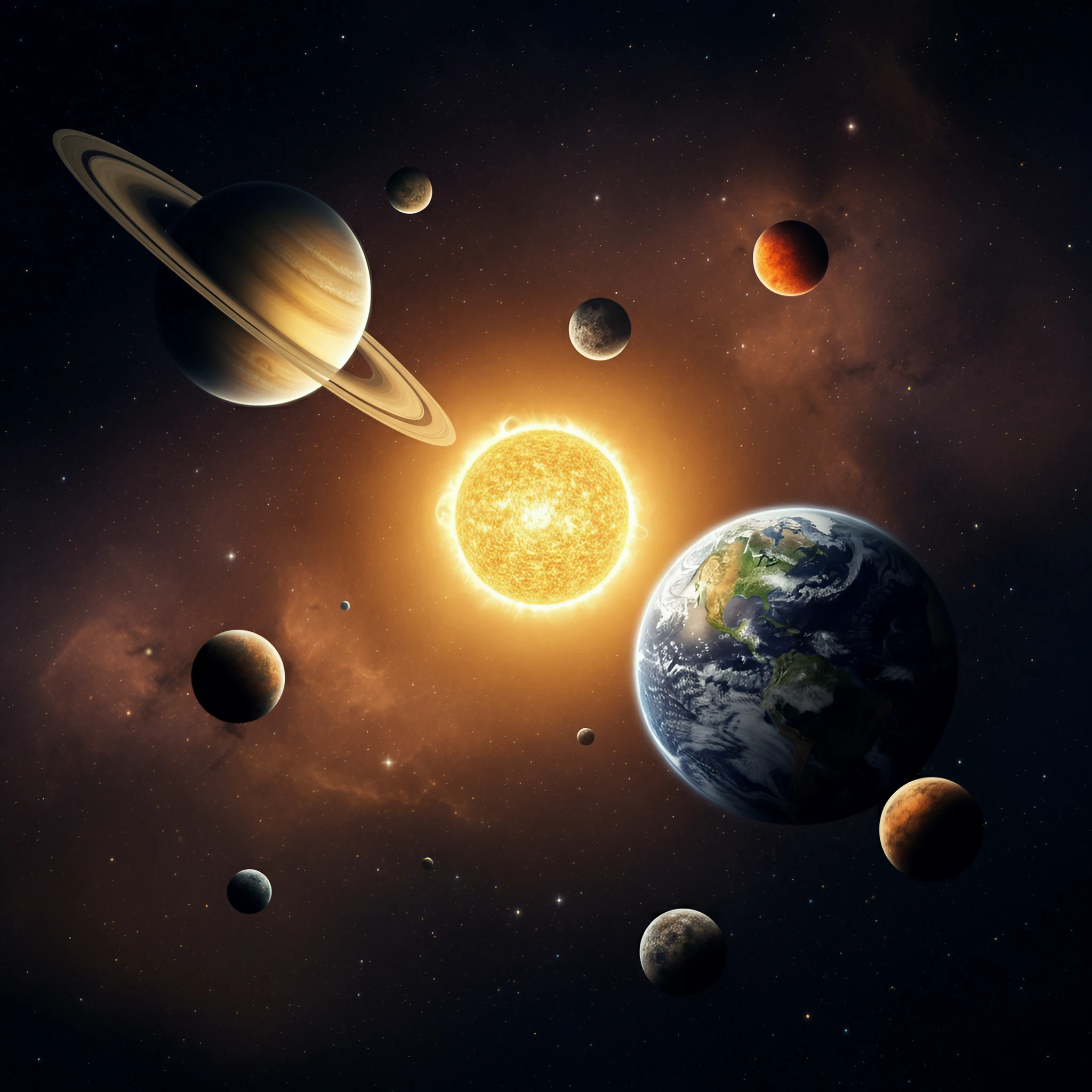The planets in our solar system make up an incredible cosmic family, each with its own unique characteristics and contributions to the solar system’s complexity. From the blistering surface of Mercury to the icy winds of Neptune, these celestial neighbors orbit the Sun in a harmony that has fascinated astronomers for centuries. This article explores the planets around the Sun, digging into their features, distinctions, and the ongoing scientific efforts to uncover their secrets.
Formation of the Solar System
Approximately 4.6 billion years ago, our solar system began to take shape when a massive cloud of gas and dust, known as the solar nebula, collapsed under its own gravity. At the center, intense pressure and heat gave birth to the Sun, while the remaining material coalesced into planets, moons, and asteroids. Governed by gravity, these celestial bodies established elliptical orbits around the Sun, with varying distances and speeds.
This early chaotic environment also determined the two main planetary categories within our solar system:
Terrestrial Planets
- Mercury, Venus, Earth, and Mars
- Smaller, rocky surfaces
- Rich in metals and silicates
- Thin or no atmosphere
Gas Giants
- Jupiter, Saturn, Uranus, and Neptune
- Larger, composed of hydrogen, helium, and other gases
- Surrounded by rings and numerous moons
The Planets Around the Sun
1. Mercury
- Distance from the Sun: 36 million miles
- Orbit Period: 88 Earth days
- Interesting Feature: Mercury experiences extreme temperatures, with daytime highs of 800°F and nighttime lows of -290°F.
Mercury is the smallest planet and the closest to the Sun. Its lack of atmosphere means it cannot trap heat, leading to dramatic temperature swings. Despite its proximity to the Sun, scientists have discovered evidence of water ice in its permanently shadowed craters.
2. Venus
- Distance from the Sun: 67 million miles
- Orbit Period: 225 Earth days
- Interesting Feature: Venus rotates in the opposite direction of most planets (retrograde rotation).
Venus is often called Earth’s “twin” because of its similar size and composition. However, its thick atmosphere of carbon dioxide creates a runaway greenhouse effect, making it the hottest planet in the solar system with surface temperatures of 900°F.
3. Earth
- Distance from the Sun: 93 million miles
- Orbit Period: 365.25 days
- Interesting Feature: Earth resides in the solar system’s habitable zone, where liquid water can exist.
Earth is the only planet known to support life, thanks to its stable climate, robust atmosphere, and liquid water. Its dynamic tectonic activity continuously reshapes its surface.
4. Mars
- Distance from the Sun: 142 million miles
- Orbit Period: 687 Earth days
- Interesting Feature: Home to Olympus Mons, the tallest volcano in the solar system.
Mars’s reddish hue comes from iron oxide (rust) on its surface. Once possibly harboring liquid water, scientists are now exploring the planet’s potential to support human colonization through missions like NASA’s Perseverance Rover.
5. Jupiter
- Distance from the Sun: 484 million miles
- Orbit Period: 12 Earth years
- Interesting Feature: The Great Red Spot is a storm larger than Earth that has raged for centuries.
Jupiter is the largest planet, boasting over 79 moons, including Europa, which may harbor an underground ocean beneath its icy crust. Its immense gravity has a protective effect, shielding inner planets from some asteroid impacts.
6. Saturn
- Distance from the Sun: 888 million miles
- Orbit Period: 29 Earth years
- Interesting Feature: Known for its dazzling ring system made of ice and rock.
Saturn’s low density means it could float in water. The planet’s moon, Titan, has a dense atmosphere and liquid methane lakes, sparking interest in the search for extraterrestrial life.
7. Uranus
- Distance from the Sun: 1.8 billion miles
- Orbit Period: 84 Earth years
- Interesting Feature: Rotates on its side, with an axial tilt of 98°.
Uranus’s faint rings and blue-green hue make it a unique object of study. Its atmosphere contains methane, giving it its color, and scientists believe its tilted axis resulted from a collision with a massive object early in its history.
8. Neptune
- Distance from the Sun: 2.8 billion miles
- Orbit Period: 165 Earth years
- Interesting Feature: Supersonic winds reaching 1,200 mph.
The outermost planet is a vivid blue due to methane in its atmosphere. Neptune’s moon Triton is noteworthy for its retrograde orbit and the potential for cryovolcanism (ice volcanoes).
Kepler’s Laws of Planetary Motion
German astronomer Johannes Kepler provided critical insights into planetary orbits through his three laws of planetary motion:
- Planetary Orbits are elliptical, with the Sun at one focus.
- Equal Areas Law means planets sweep out equal areas in their orbital path over equal times.
- Planetary Period Law reveals the relationship between a planet’s orbital period and its distance from the Sun.
These laws are fundamental to understanding the motion of planets and their interactions with the Sun’s gravity.
The Habitable Zone and Life Beyond Earth
The habitable zone, or “Goldilocks Zone,” is the region around a star where conditions may be just right for liquid water to exist. Earth sits comfortably within this zone, but bodies like Mars and Europa are also prime targets for the study of potential extraterrestrial life.
Current Research and the Search for Planet Nine
Scientists continue to explore our cosmic neighborhood through space telescopes and robotic missions. Additionally, researchers are investigating the possibility of a hypothetical Planet Nine, a massive yet unseen object influencing the orbits of outer solar system bodies. Until it is directly observed, its existence remains speculative.
Final Thoughts
The planets around the Sun are an intricate part of the cosmic ballet that showcases the beauty and mystery of our universe. From striking storms on Jupiter to potentially habitable zones on Mars, the wonders of our solar system are abundant.
Are you ready to learn more or contribute to scientific exploration? Keep looking up, pondering the vastness, and imagining the possibilities that lie in our celestial backyard.








